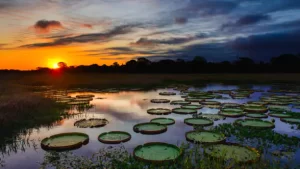The Pantanal, the world’s largest tropical wetland, is a vast and unique ecosystem teeming with wildlife and natural beauty. Located primarily in western Brazil, it spans parts of Mato Grosso and Mato Grosso do Sul and extends into Bolivia and Paraguay. Known as a paradise for wildlife enthusiasts, the Pantanal offers unparalleled opportunities for eco-tourism, birdwatching, and cultural exploration.
Essential Information
- Language: Portuguese
- Currency: Brazilian Real (BRL)
- Time Zone: Brasília Time (GMT-3)
- Climate: Tropical, with a rainy season from November to March and a dry season from April to October.
- Best Time to Visit: July to October, during the dry season when animals congregate around shrinking water sources.
- Accessibility: Many areas of the Pantanal are remote and best accessed via guided tours or local operators.
Interesting Facts About the Pantanal
- The Pantanal is home to over 1,000 species of birds, 400 species of fish, 300 species of mammals, and 480 species of reptiles.
- It is one of the best places in the world to spot jaguars in the wild.
- Unlike the dense Amazon rainforest, the Pantanal’s open landscapes make wildlife viewing much easier.
- The name “Pantanal” comes from the Portuguese word “pântano,” meaning swamp.
How to Get There
- By Air: Fly into Campo Grande (CGR) or Cuiabá (CGB), the main gateways to the northern and southern Pantanal.
- By Road: From Campo Grande or Cuiabá, travel to nearby towns like Corumbá or Poconé, which serve as entry points. The Transpantaneira Highway is a scenic route into the region.
- By River: Some areas of the Pantanal can be accessed by boat tours from nearby towns.
Best Things to Do in the Pantanal
- Wildlife Safaris: Spot jaguars, giant otters, capybaras, and caimans in their natural habitat.
- Birdwatching: Observe colorful species like the hyacinth macaw, toucans, and jabirus.
- Fishing for Piranhas: Learn traditional fishing techniques and enjoy the thrill of catching these infamous fish.
- Boat Tours: Navigate the waterways to explore remote areas and see aquatic wildlife.
- Horseback Riding: Traverse the wetlands like the local pantaneiros (cowboys).
- Visit Fazenda San Francisco: A working ranch offering eco-tourism experiences and insights into local culture.
- Sunrise and Sunset Tours: Witness the breathtaking colors of the wetlands as the day begins and ends.
Best Accommodation Options
- Luxury:
- Caiman Ecological Refuge (Mato Grosso do Sul): Offers luxurious lodges, expert-guided wildlife tours, and a focus on conservation.
- Araras Eco Lodge (Mato Grosso): Combines comfort with eco-friendly practices and excellent wildlife activities.
- Mid-Range:
- Pousada Piuval: A rustic lodge with access to hiking trails, boat tours, and horseback riding.
- Pousada Aguapé: A family-run lodge providing authentic Pantanal experiences.
- Budget:
- Pousada Rio Claro: An affordable option offering basic amenities and guided activities.
- Camping Options: Available in some areas for adventurous travelers.
Good Attractions
- Transpantaneira Highway: A 147-kilometer dirt road with dozens of wildlife-viewing opportunities along the way.
- Aquário Natural (Natural Aquarium): A crystal-clear water spring near Bonito, perfect for snorkeling.
- Chapada dos Guimarães National Park: Located near Cuiabá, this park features waterfalls, caves, and scenic views.
- Carandá Lagoon: A hotspot for birdwatching and serene boat rides.
Getting Around
- Guided Tours: The easiest and safest way to explore the Pantanal, as guides know the terrain and wildlife behavior.
- 4×4 Vehicles: Necessary for navigating rugged roads during the dry season.
- Boats: Essential for accessing flooded areas during the rainy season.
- Horseback: A traditional and practical way to traverse wetlands.
Day Trips
- Jaguar Spotting in Porto Jofre: Spend a day on a river safari to see jaguars and other wildlife.
- Explore Bonito: Visit nearby Bonito for cave diving, snorkeling, and freshwater springs.
- Birdwatching Excursions: Spend a day identifying some of the Pantanal’s most iconic birds.
- Visit Corumbá: Learn about local history and culture in this charming riverside town.
Practical Tips
- Pack Smart: Bring lightweight, breathable clothing, insect repellent, sunscreen, waterproof gear, and binoculars.
- Health Precautions: Stay up-to-date on vaccinations and consider anti-malarial medication. Drink only bottled or filtered water.
- Respect Wildlife: Observe animals from a safe distance and never feed or disturb them.
- Hire Local Guides: Their expertise will enrich your experience and ensure your safety.
- Seasonal Awareness: Plan your visit based on your interests—dry season for jaguar spotting and wet season for lush landscapes.
Conclusion
The Pantanal is a natural wonder unlike any other, offering unmatched opportunities to connect with wildlife and experience Brazil’s ecological richness. Whether you’re gliding through waterways, riding horseback across open plains, or marveling at the region’s diverse fauna, the Pantanal promises a once-in-a-lifetime adventure.

